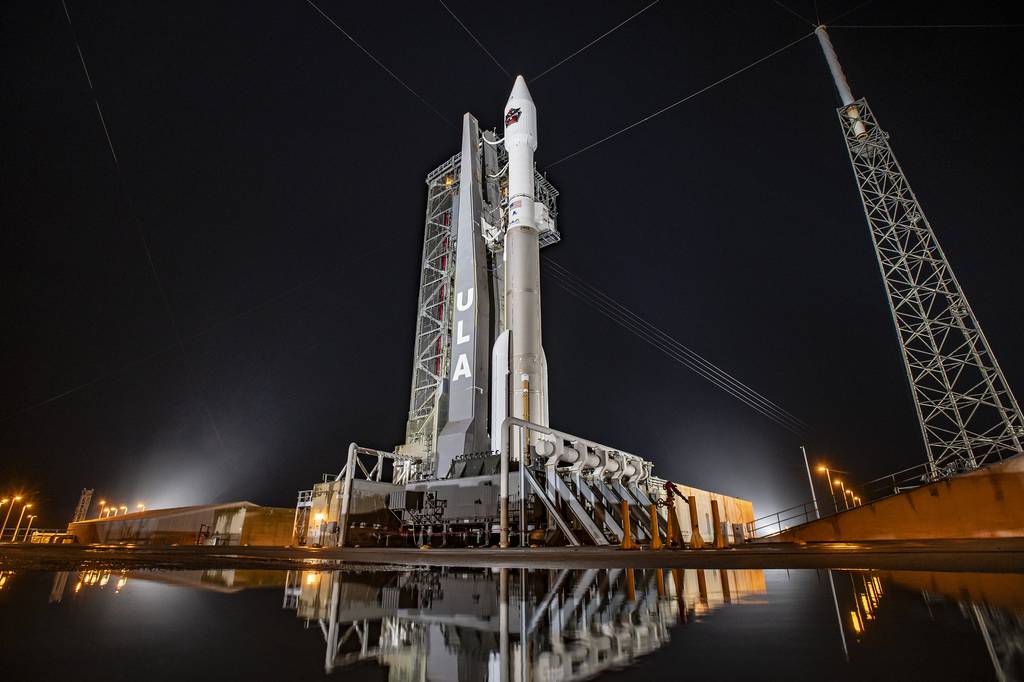CAPE CANAVERAL SPACE FORCE STATION, Fla. — The Space Based Infrared System provides 24/7 coverage of the globe, detecting the launch of missiles and providing a critical early warning of possible threats to American war fighters. For instance, the satellite system provided U.S. and allied forces a last minute warning to seek cover when Iran launched more than a dozen ballistic missiles at bases in Iraq in January 2020. In 2019, the constellation detected nearly a thousand missile launches.
On Tuesday, somewhere 22,000 miles above the Earth’s surface, one of the four missile warning satellites in geostationary orbit probably detected the launch of a rocket off the coast of Florida.
But the rocket launched from Cape Canaveral wasn’t a threat — it’s backup.
At 1:37 p.m., a United Launch Alliance Atlas V rocket lifted off in a fiery plume from the recently renamed Cape Canaveral Space Station, carrying the fifth and penultimate SBIRS satellite into orbit. It’s job is to replace an older satellite.
Approximately 45 minutes later, the rocket successfully delivered the $1 billion satellite to its destination in geosynchronous orbit. However, work on the satellite isn’t complete. It will now enter a six-month testing period before the Space and Missile Systems Center hands it over for operational use.
“The space acquisitions process is not complete until assets are delivered on orbit, tested for functionality, and handed over to the operations arm of the space enterprise,” said Brig. Gen. D. Jason Cothern, Space and Missile Systems Center Vice Commander and Program Executive Officer for Space Enterprise. “Launch is the great connector of fully integrated space capability.”
SBIRS is made up of four geosynchronous satellites, each with two sensors — a scanner that continuously monitors the Earth and a step-starer that can provide more accurate coverage for theater missions. In addition to the now five SBIRS GEO satellites, the Space Force operates two SBIRS payloads on host satellites in highly elliptical orbits, providing coverage of the polar regions with scanner sensors.
In 2014 the U.S. Air Force awarded Lockheed Martin $1.86 billion to build two more SBIRS satellites to replace the first two. SBIRS GEO 5 will eventually replace the first SBIRS GEO satellite, launched in 2011.
There were originally supposed to be even more replacement satellites, but in 2018 Congress opted to discontinue the SBIRS constellation, canceling planned seventh and eighth satellites. Instead, lawmakers tasked DoD with developing and launching a new constellation to eventually replace SBIRS. That constellation, Next Generation Overhead Persistent Infrared, is slated to be delivered in 2025.
Along with the SBIRS GEO satellites, Lockheed Martin is also the prime contractor for the first three Next Gen OPIR GEO satellites. The company was awarded $2.9 billion to design the satellites in 2018, and another $4.9 billion in 2021 to build them. Those are expected to begin launching in 2026. Northrop Grumman secured $2.9 billion to build two more Next Gen OPIR satellites for polar coverage.
This was the first launch of a U.S. military satellite using Lockheed Martin’s new LM 2100 Combat Bus, which features greater resilience, cyber hardening, enhanced power and common components that can streamline manufacturing, according to Vice President for Overhead Persistent Infrared Missions Tom McCormick. While the SBIRS GEO 5 and 6 satellites were originally contracted to be built on the same buses as the original constellation, Lockheed Martin opted to upgrade them to LM 2100 bus at no additional cost to the government. The company will also build the three Next Gen OPIR GEO satellites on the LM 2100 bus.
Tuesday’s Atlas V launch was the first for the Space Force out of Cape Canaveral in 2021. In addition to the SBIRS satellite, the rocket carried two tech demonstration satellites with multiple experimental payloads for the U.S. Air Force Academy. Secured on the aft end of the Centaur upper stage, those two satellites were deployed about 15 minutes into the launch.
ULA has launched all of the SBIRS satellites and will launch the sixth as well. SBIRS GEO 6 is on track for a 2022 launch.
Nathan Strout covers space, unmanned and intelligence systems for C4ISRNET.








